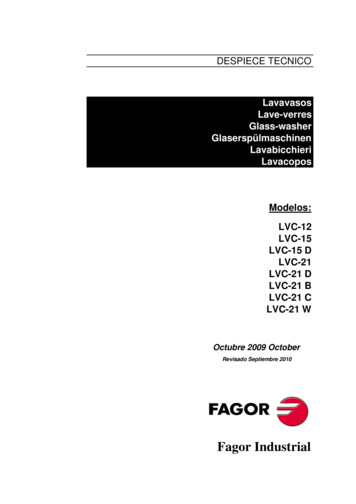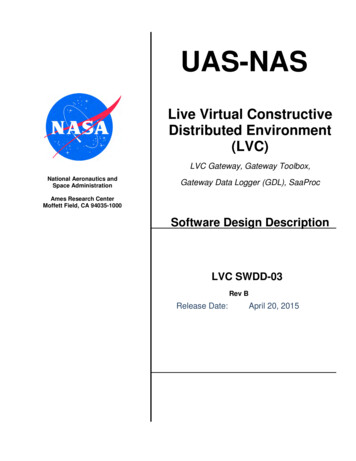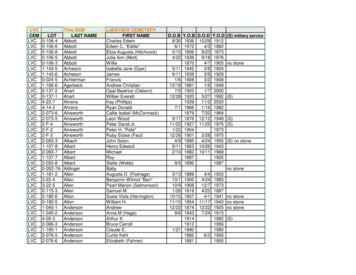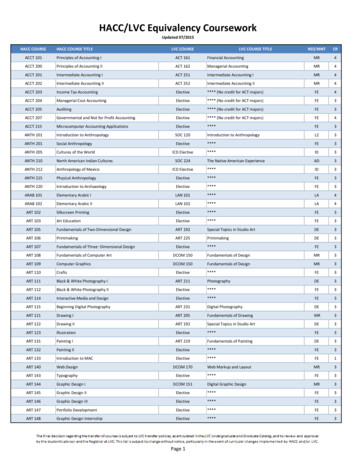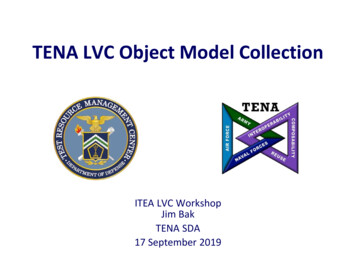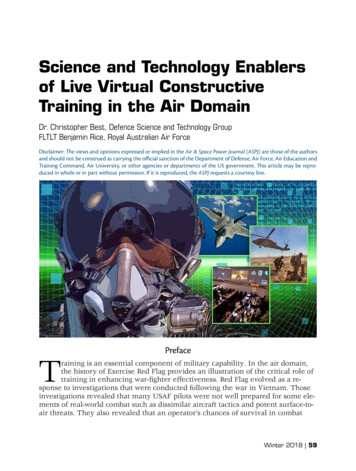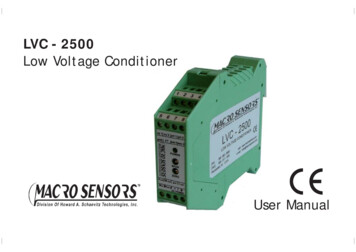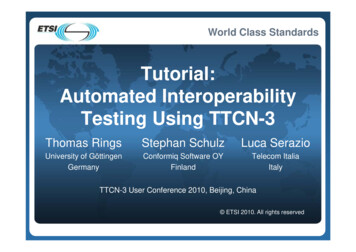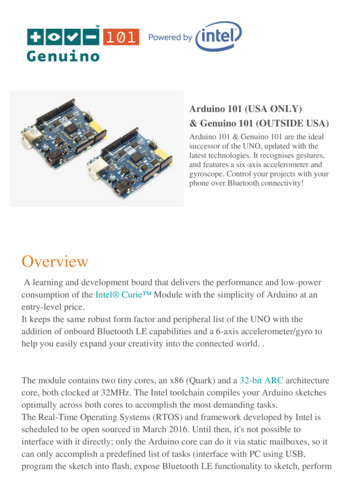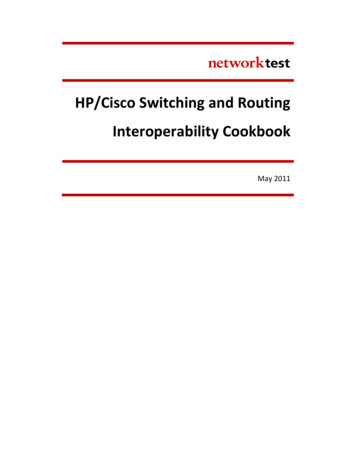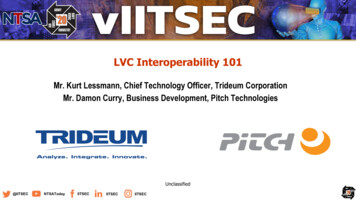
Transcription
LVC Interoperability 101Mr. Kurt Lessmann, Chief Technology Officer, Trideum CorporationMr. Damon Curry, Business Development, Pitch ECIITSEC
Agenda1.2.3.4.5.6.@IITSECLearning ObjectivesLVC Interoperability OverviewInteroperability Through StandardsInteroperability Using Gateways and Cross Domain SolutionsLVC Interoperability Use CaseSummaryNTSATodayIITSECIITSECIITSEC
1. Learning ObjectivesØØThe tutorial is intended for decision makers who need a top-level understanding ofLive, Virtual and Constructive (LVC) interoperability and the supporting standards,technology and processes.The tutorial will provide:nnnØ@IITSECAn overview of recommended concepts, processes and tools needed to achieveinteroperabilityUse Case that demonstrates interoperability solutions meeting a military training needSummary with recommendationsThe objective of this tutorial is to provide managers and those new to LVCtechnology the high-level insight needed to support intelligent decision makingwhen encountering a need for interoperabilityNTSATodayIITSECIITSECIITSEC
2. LVC Interoperability OverviewØØØ@IITSECSimulation DefinitionsLVC Interoperability DefinitionsDistributed Environment OverviewNTSATodayIITSECIITSECIITSEC
LVC Interoperability OverviewØSimulationnnØA software model that runs over timeAll but war is simulationSimulation InteroperabilitynThe ability of connected systems to communicate and function togetherInteroperable components can be combined to create an application applications can be composed to create a system, and systems can becombined to create a System of Systems (SoS)@IITSECNTSATodayIITSECIITSECIITSEC
Live Virtual Constructive (LVC) Definition @IITSECLive SimulationVirtual Simulation“Real people operatingreal systems”“Real people operatingsimulated systems”Real environmentReal systemsReal peopleReal-time Various kinds ofplatform simulators Virtual Environment Real-timeNTSATodayIITSECIITSECIITSECConstructive Simulation“Simulated People operatingsimulated systems” Computer GeneratedForces (CGF) Virtual Environment Faster/slower than realtime
Distributed SimulationØA distributed simulation is a system that:nnØSimulations can be distributed over a number of different components, ideally looselycoupled or “federated”nnnØInvolves several independent processes executing on one or more computational nodesInteroperates using a common services and/or protocol over a networkAllows growth over timeAllows components to be replaced or upgraded easilyAdd additional computational power if neededDistributed Simulation can be used to supportn@IITSECWarfighter Training, Command Post Exercises, Enhanced Modeling and Simulation Objectives,Research, Development Test and Evaluation (RDT&E), etcNTSATodayIITSECIITSECIITSEC
Distributed LVC EventØDistributed LVC EventnAn activity to integrate and execute LVC simulations in a virtual environment so that “realworld” processes and “things” can be exercised to investigate and solve complex issuesvnnnReal-time for live systems, Can be faster than real-time for virtual and constructive systemsTechnique used to enhance weapons system development, test and trainingCan be an effective tool to enhance effectiveness, reduce risk, reduce costExamples includevStimulating a ”real” fire control radar with simulated targets to conduct common operator trainingexercises at multiple training locationsIntegrated withConnected LVC systems@IITSECNTSATodayIITSECRunning over timeVirtual and/or Real EnvironmentIITSECIITSECLVC Event
Interoperability RequirementsØInteroperability RequiresnnØEfficient software reuse and composability is enabled bynn@IITSECAn ability to meaningfully communicatev A common “language” to describe the LVC systemsv A data distribution mechanism with well-defined rules and/or servicesv A reliable networkA common contextv A common understanding of the environment and timev A common technical processWell-defined software interfaces and access to reusable componentsThe ability to replace models at the component level, without interrupting the larger systemor requiring software changes or recompilation to other system componentsNTSATodayIITSECIITSECIITSEC
Typical Interoperability DiscussionsØWhat is theInformationDataExchangeModel?What is theconceptualmodel of theentireexercise?Whichcoordinatesystems areused?Conversions?What logicalsequences ofinteractionsare required?Fair fight?@IITSECNTSATodaynWhatalgorithms(such as lineof sight) needto be shared?What objectnames(marking) areused? Objecttypes?Whatrepresentationof theenvironment isused?Timehandling?Starting ��s a unique language andskill set that takes time tounderstand and adoptØInvolvement with theinteroperability communityoptimizes this processApplying standardarchitectures, processes,technologies and lexicon isa key to success
LVC Distributed Event EnvironmentJoint MissionEnvironmentTest Capability(JMETC) visionof Standardsbased SEC
3. Interoperability through StandardsØØThe Value of StandardsPast and Current Interoperability StandardsnØ@IITSECDIS, HLA and TENARecommended LVC Integration ApproachNTSATodayIITSECIITSECIITSEC
The Value of Interoperability StandardsUse myproprietaryarchitecture!Use myproprietaryarchitecture!OpenStandardSolutions Data ModelUse myproprietaryarchitecture!Use myproprietaryarchitecture! Application ProgrammersInterface (API) Integration ProcessesRemoveStovepipesGood for me right now@IITSECNTSATodayIITSECIITSECIITSECGood for allnow and in the future13
Goals of Interoperability StandardsTechnical AspectsØEnable efficient distributed simulationPromote interoperability and reusenSupport simulation specific requirementsnnnØØThroughput, latency, scalability etc.nØBusiness AspectsNot limited to data distributionProvide common services (RemoteMethods, Time Management,Ownership (control over dataelements), etc.)Isolate simulator from physical transportmethod (i.e. network)nAvoid technology lock-inØVendor independentnnnØNTSATodayIITSECIITSECIITSECVendors and organizations equally comfortablewith the standardOpen standard for contributions and influenceEasily replace interoperability implementationDomain neutralnn@IITSECLeverage exiting solutions for other needsIncreased customer supportSupport the simulation market as a whole,multi-purposePossibility to attract a large number of vendorsand users14
Interoperability Approaches of the PastØStandardize on a vendor solutionnnØStandardize on programming languagennØOptimized for a specific needCreates a vendor-lock situation for computers and/or softwareOptimized for a specific needProblems may occur when maintaining code developed using older programminglanguages and compilers the remember ADA mandate?Incorporation of new software technologies becomes very difficult (ServiceOriented Architectures (SOA), cloud based solutions, scripting languages, etc.)This approach was adopted when reuse, composability andinteroperability were not high priorities@IITSECNTSATodayIITSECIITSECIITSEC15
Modern Interoperability ApproachesØStandardize on the Data ModelnnØStandardize on a software Application Programmers Interface (API)nØData Model is the defined network protocol or message formatThis defines the data needed to interoperateProvides software interface to interoperability services and solutions fordistributed simulationsStandardize on ProcessesThese Modular Open Systems Architecture (MOSA) concepts enablesuccess and solution flexibility now and in the future@IITSECNTSATodayIITSECIITSECIITSEC16
Interoperability Standard: Data Models Enable semantic interoperability among simulation applications Provide the “common language” that all simulation applications use to communicate Data Models Object Model(OM) Data Exchange Agreement (DEM)Conceptual Level(common understandingof information)Pragmatic/DynamicLevel(common use of information)Object ModelSemantic Level(information exchange)A documentdescribing thedata that willbe exchangedSyntactic Level(data exchange)Airplane!Technical Level(networking)Levels of Interoperability (Tolk)@IITSECNTSATodayIITSECIITSECIITSEC1717
Interoperability Standard: APIØApplication Programmers Interface (API) is a software interface to software services thatenable interoperabilitynTime ManagementnnQuality of Service (in simulation)nnTransfer of modelling responsibility from one participating application to anotherData Distribution Management, DDMnnServices for managing how data is distributed on the networkOwnership ManagementnnManage and synchronize time between participating applicationsData filtering based on regions or any other attribute to reduce data loadRemote Method Invocation, RMInParticipating applications can have methods that can be remotely invoked by other applicationsThese services have made significant enhancements to LVCinteroperability. Understanding these capabilities and implementing themusing common practices improves performance and reduces risk@IITSECNTSATodayIITSECIITSECIITSEC18
Interoperability Standards: Integration ProcessØA well-defined Integration Process is critical to successnnFirst step in planning for an LVC Environment is identification and adoption ofa proven process to support the design, integration and execution of theenvironmentTo ensure the environment is designed and configured to meet the eventrequirements, a structured process is necessary to properly identify needs,deigns and solutions.vv@IITSECSeveral standard, and proven, processes exist.Do not add risk to your program by “winging it” through a very complex endeavorNTSATodayIITSECIITSECIITSEC
Open StandardsØAccording to the Software Engineering Institute a system is open if: It is fully definedAvailable to the publicMaintained according to group consensusSupport Organizations for Interoperability Standards include: @IITSECInstitute of Electrical and Electronics Engineers (IEEE) n Interoperability Standards Organization(SISO) https://www.sisostds.org/TENA Architecture Management Team C20
The “Big 3” LVC Interoperability Architecture StandardsØ Distributed Interactive Simulation (DIS) - IEEE 1278n Protocol standardn Covers several levels of interoperabilityn Broadcast/Multicast UDP (Best effort)Interoperability Standard:Data ModelØ High Level Architecture (HLA) – IEEE 1516-2010 and NATO STANAG 4603n API standardInteroperability Standard:n Separate semantic model expressed in a (Federation) Object ModelData Model, API & Processn Services standard – A rich set of interoperability servicesØTest and Training Enabling Architecture (TENA)Interoperability Standard:n API standard –auto-generated user software for quality and usabilityData Model, API & Processn Semantic model expressed in a Standard Object Modeln Includes standard object model, extensive middleware services and a set of interoperability & event support tools@IITSECNTSATodayIITSECIITSECIITSEC21
Interoperability vs InterconnectivityØ LVC “Interoperability” requires data exchange with other systems without requiring modification toalready connected systems, thus permitting flexible connections.Ø “Interconnectivity” involving some data exchange protocols requires system-wide changes,recompilations of source code, re-linking to new software libraries, etc, thus implementingspecific connections.Ø Many (an infinite number?) of data messaging methods exist. Examples are:@IITSECNTSATodayIITSECIITSECIITSEC22
Interoperability vs InterconnectivityØ Data Distribution Service (DDS)n API standardn Available through the Object Management Group (OMG) www.omg.orgn For real-time interconnectivity of systems exchanging data via DDSn Common application is for “Internet of Things” (IoT), to enable interconnected systems to exchange dataover a networkn DDS uses some similar concepts as TENA and High Level Architecture (HLA)n Publish-Subscribe architecturen Data model HLA has a “Federation Object Model” DDS has a “Data Space”n Targeted use interconnectivity, e.g. Internet of Things (IoT) applicationsn Does not provide runtime interoperability services (e.g. time management) like HLAn Cannot be used in place of HLA but could be used in conjunction with HLAn Often confused item:n HLA has a “Run Time Infrastructure” (RTI) DDS has no equivalentn The best known company providing DDS software is “Real-Time Innovations” (RTI)@IITSECNTSATodayIITSECIITSECIITSEC23
Timeline Of Interoperability StandardsDISv82020TENA ardNETN TSECIITSEC24
Distributed Interactive Simulation (DIS) OverviewDISApplicationsNetworkØDIS IEEE 1278 is an “Over the Wire” specificationnnnnnnØ@IITSECDefines the structure of data sent over the networkusing a Protocol Data Unit (PDU)Is a binary protocol where individual bits are defined and bit order and byte order is mandatedDefines behavior of message handling. Receiving participants must review each packet forapplicabilityDoes not include an “API” or implementation details or solutionsFollows the COTS and Open Source business modelsPrimarily focuses on military systems/requirementsDIS participants must Broadcast or Multicast data on a local network using UDPnetwork transfer protocolNTSATodayIITSECIITSECIITSEC25
Distributed Interactive Simulation (DIS) Example PDUDISApplicationsNetworkØExamples: DIS “Entity Type” PDUnUSAF F-16C Falconnnnnnnn@IITSECNTSATodaynEntity Kind 1Domain 2Country 225Category 1Sub Category 3Specific 3Extra 0IITSECIITSECUSAF F-22B RaptornnnnnnnIITSECEntity Kind 1Domain 2Country 225Category 1Sub Category 6Specific 2Extra 026
High Level Architecture (HLA) OverviewØØØØDefines services for simulation data exchange and coordination provided by aRun-Time Infrastructure (RTI)Services are accessed through a standardized interface.A data model (Federation Object Model FOM) expressed in a standardized textfile, using the xml standard, defines how objects interact with each otherInformation exchange governed by Federation Agreements and supportingfederation Information Data Exchange Models (IDEM)oØe.g. when, where and how to utilize the service to distribute data in order to exchange informationUses COTS and Open Source business modelsFederatesFederation Object Model FOM Shared object classes Shared interaction classes More /FOM HLA APIRTI Services@IITSECNTSATodayIITSECFederation ManagementDeclaration ManagementObject ManagementIITSECIITSECOwnership ManagementTime ManagementData Distribution Management27
DIS and HLA Data Model & ication”HLA Real-time Platform ReferenceFOM (RPR-FOM) SISO-STD-001DIS IEEE 1278 Data ModelDIS and HLAare maintainedthrough ndustryAcademiaEtc-COTS, GOTSIn-houseOpen sourceOther- Research- Student projects- CoursesIEEE is the externalstandards body for SISO28
TENA OverviewTENA is the DoD GOTS live range integration architectureØWhat does TENA enable?nnnnnØWhat is included in the TENA architecture?nnnnØ@IITSECInteroperability between inter- and intra-range assetsElimination of proprietary interfaces to range instrumentationEfficient incremental upgrades to test and training capabilitiesIntegration of Live, Virtual, and Constructive assets (locally or distributed)Sharing and reuse of common capabilities across existing and new investmentsCustomizable “data contracts” that standardize repeatable information exchangeInteroperability-enabling, auto-code generated software librariesA core set of tools that address common test and training requirementsCollaboration mechanisms that facilitate sharing and reuseTENA is continuing to be evolved and has institutional fundingNTSATodayIITSECIITSECIITSEC
TENA-Enabled Interoperabilitylllllllllll@IITSECCommon specifications for test and training dataData Dissemination across variable applications, platforms,programming languages, networks, and classification levelsData Collection and PlaybackDataManagementLocal and Remote Command and ControlHealth & Status MonitoringEventManagementReal-Time simulationsStimulation of live sensors and instrumentationConnecting non-interoperable inter- and intra-range systemsLVCIntegrationEliminating proprietary interfaces to range instrumentationSharing and reuse of common range tools and capabilitiesOnline Collaboration and File SharingSharing &ReuseNTSATodayIITSECIITSECIITSEC
Test and Training Enabling Architecture (TENA) OverviewTENA ApplicationsTENA ToolsHWILRange ResourceApplicationTENATENAObject TENA pplicationReusableApplicationsTENA MiddlewareTENA MiddlewareTENARepositoryLogicalRange DataArchiveTENA Common InfrastructureObject agement andPlanning NA CommunicationsNon-TENASystemTENA Utilities@IITSECReusableApplicationsIITSECØ100% Government off the Shelf (GOTS) Initially developed to support the demandsof live system testing Provides tools for common Event Planning,Execution, and Analysis functions Provides Subject Matter Experts to supportdistributed exercise and system integration Community-managed Open Architectureand Standards Constantly improved to meet new userrequirements Download TENA Middleware and tool set http://www.tena-sda.orgNon-TENASystemNon-TENA ApplicationsIITSECIITSEC31
TENA Data Model & StandardizationØØØThe DoD maintains the extensive and extendable TENA Standard Object ModelObject Models were initially based on Live Test and Training Range requirementsVirtual and constructive simulation requirements are now includedØPlatform n-v3nTENA-SyncController-v1nTENA-UniqueID-v3JNTC OMs (for reat-v2NTSATodayIITSECTime-Space Position Information(TSPI) -v2Other v4TENA-Exercise-v1TENA-GPS-v3TENA-Radar-v3.1TENA OM for RPR FOMTENA OM for HLATENA om for DISEtc, etc., etc.IITSEC TENA is funded, maintained, enhanced andprovided via US Department of Defense(DoD) Test Resources Management Center(TRMC) Also sponsors JMETC for DoD-widepersistent network connectivityTest LessonsLearnedLearnedLearnedTRMC’s TENA Architecture ManagementTeam (AMT) comprised of Govt, industryand academia32
Recommended Integration ApproachØIdentify a Common ArchitecturenØESB Provides Ability to Meaningfully Communicate for Reuse and ComposabilitynnØUtilize horizontal Integration using Enterprise Service Bus (ESB) concept (HLA, TENA, etc.) when possibleStandard Data Model to describe the data communicatedStandard Services Interfaces (API) Software provides the Standard Services using Standard APIs e.g. Services to distribute the data modelSubsystems are called Federates. The Integrated System is called a Federation.FederatesAPI andData ModelsSoftware infrastructure@IITSECNTSATodayIITSECIITSECIITSEC33
Identify Integration ProcessØSuggested standards and guidelines includennnØIEEE Std 1730-2010 - IEEE Recommended Practice for Distributed Simulation Engineering and Execution Process(DSEEP)IEEE Std 1730.1-2013 - IEEE Recommended Practice for Distributed Simulation Engineering and Execution ProcessMulti-Architecture Overlay (DMAO)TENA Concepts of Operations (CONOPS)HLA Distributed Simulation Engineering and Execution Process (DSEEP) OverviewnnnnIEEE 1730-2010 was developed based on authoritative systems engineering processes that were adopted and extendedto address distributed simulation requirementsIdentifies and describes the sequence of activities necessary to construct and run distributed simulationsA high-level process that is relevant to and can facilitate the development of solutionsIs independent of interoperability ent234IITSECIITSECIntegrateand ment6Analyze Dataand EvaluateResults7
Focus on CommunicationØTools like Interface Matrices and Connectivity Diagrams are effective at communicatingevent design across the teamnnThese diagrams ensure clear communication and that implementation mirrors designKey data includes: Location, IP, Port, Protocol, messages, and system namesSee vI/ITSEC 2020 Tutorial20017 : by Mr. MichaelO’Connor, TrideumCorporation for more details@IITSECNTSATodayIITSECIITSECIITSEC
4. Interoperability Using GatewaysØØComplex LVC environments may require interoperability between simulationfederations using different architecturesGateways are bridges between different simulation architecturesnExamples:nnTENA used at a test range interoperating with other facilities using DIS, HLA, or bothLegacy DIS-based system interoperating with newer HLA-based systemExample gatewayHLAHLA GatewayDISDIS v736
Interoperability Using GatewaysØGatewaysnnnØØCaution: Placing a gateway may create a single point of failure for the system.Careful system design can minimize this potential problem.A top level “system design” trade-off analysis that considers schedules, costs,technical factors, etc., should determine the best of two implementation methods1.2.@IITSECTranslate data and services between different middleware, object models, and servicesCan filter data, transferring some data while blocking other dataCan provide logging, monitoring, and detection and notification of errors or issuesSelecting a common architecture for the entire LVC environment, orImplementing, integrating, testing, operating and maintaining gateways.NTSATodayIITSECIITSECIITSEC37
Interoperability Using GatewaysØCommonly used gateways are available as Commercial Off-The-Shelf (COTS)products from numerous vendors.n@IITSECCheck carefully the product’s list of translated data types, models, and services!!ØTENA-related gateways can be downloaded from the TENA website.ØSometimes unique modifications are needed, especially when a gateway isinterfaced to a “stove-piped” (non-standards-based) system.NTSATodayIITSECIITSECIITSEC38
Multiple Levels of SecurityDefinitions:ØØSecurity DomainØØCross Domain Solution (CDS) aka Multi Domain Operations (MDO)ØØØSystem or group of systems operating under a common security policyAn information assurance solution that provides the ability to access or transfer informationbetween two or more security domainsEnables data transfers between Unclassified, Secret, Top Secret, Top Secret/SCIWhen establishing a complex distributed environment, information transferbetween two or more security domains may be neededØMost organizations do not have any effective means to address this issueØ@IITSECAs a result, too often the “solution” is a brute-force denial of access to information, thusseverely limiting system effectivenessNTSATodayIITSECIITSECIITSEC
Purpose of Cross Domain SolutionsLevel of Trust(totally open)(totally protected)Rule SetLogic, Math, &Comparative OperationsLow SecurityDomainNetwork 1Filter Decisions Block Sanitize PassHigh SecurityDomainNetwork 2 Enforces Relevant Security Classification Guidance The CDS default state is to block all traffic. Data owner guidance is implemented through user-definable, event-specific, Rule Sets. Rule Sets define if and how designated traffic can pass through. Rules must support event objectives and classification guidance. Logical operations (e.g. AND, OR, NOT) Mathematical operations involving object attributes (e.g. addition, subtraction,multiplication, division, exponents, logs, trig) Comparative operations ( , , , , ): how object attributes relate to fixed values40@IITSECNTSATodayIITSECIITSECIITSEC
CDS: Multiple Protocol ExampleØ Gateways enable broader use of existing CDSsHLASourceHLA/TENAGatewayCDSUnclassified NetworkHLA/TENAGatewayHLADestinationClassified NetworkØ There are two federations running in different Security domains, each usingHLAHLA to interoperateØ The example CDS meets requirements yet has a native TENA interfaceØ Gateways are used to translate between HLA-based simulations and TENAØ Approach enables HLA-based environments to use existing TENA-based CDS41@IITSECNTSATodayIITSECIITSECIITSEC
5. LVC Interoperability Use CaseØThe Task: A ground-based Commandand Control (C2) system is beingenhanced and must be tested.nnn@IITSECThe present test method stimulates the C2system under test with real data sent from alive aircraft via a Tactical Data Link (radio).This is a *very* expensive way to test aground-based C2 system.Great savings would be achieved if thetests used a flight simulator instead of areal aircraft.NTSATodayIITSECIITSECIITSECC2 system under testTactical Data Link(TDL), e.g. Link16
LVC Interoperability Use CaseØAn available flightsimulator has a Link 16“Data Link Processor”(interface), so the flightsimulator can be usedto stimulate the C2system under test.C2 system under testTactical Data Link(TDL), e.g. Link16Data LinkProcessorEverything’s good right?@IITSECNTSATodayIITSECIITSECIITSEC
LVC Interoperability Use CaseØAnalysis of the “real world”reveals:nnnn@IITSECThe flight simulator has an olderHLA 1.3 interface and uses avendor-modified version of the RPRFOM (“Didn’t anyone tell them toavoid building stove-pipes?!!”)A scenario generator, with DIS &SIMPLE interfaces, is available toinsert simulated tracks of otheraircraft into the Link 16 network.The data link processor has aSIMPLE interface.Link 16 is represented in two ways,standards-based and non-standardsbased.NTSATodayIITSECIITSECC2 system under testTactical Data Link(TDL), e.g. Link16HLA 1.3 withproprietaryadditions to FOMData LinkProcessorSIMPLEDISIITSECScenarioGenerator
LVC Interoperability Use CaseØDSEEP-driven feasibility studysuggested:nnnØUse HLA as the commoninteroperability solutionInsert an HLA to HLA bridge tofilter/modify vendor-specific (nonstandard) RPR-FOM extensionsUse a gateway from HLA/RPRFOM to DIS, to connect with theScenario GeneratorSome Limitations Accepted:nnn@IITSECSimulator data is accepted as the“ground truth”“J messages” from flight simulatorare not bridgedNo voice communicationsNTSATodayIITSECIITSECC2 system under testTactical Data Link(TDL), e.g. Link16HLA 1.3 withproprietaryadditions to FOMData LinkProcessorstandardHLA 1516SIMPLEBridgeHLA 1.3 toHLA 1516IITSECGatewayHLA-DISDISScenarioGenerator
LVC Interoperability Use CaseØIntegration spiral demonstrated:nnnnnØØSuccess! Initial tests produced good results with previously known limitationsAdditional actions required:nnn@IITSECSelecting HLA as a standard was appropriate due to HLA technology and performance plus existing HLAbased solutions and experienceRPR-FOM extensions, HLA to DIS gateway, and HLA to HLA bridge concepts were acceptableThe DIS network did not work due to computer clocks not being in sync (or set correctly)The scenario generator’s DIS interface only worked in one directionSecurity aspects needed further analysisUpdating the Scenario Generator’s DIS interfaceGetting approval from responsible authorities to synchronize the computer clocksGetting approval to run tests with a dedicated Link16 network and the participating real aircraft on the ground(when the flight simulator was not being used as a substitute for the real aircraft, and to validate data)NTSATodayIITSECIITSECIITSEC46
6. Summary: StandardsØThere are several standards available for Live-Virtual-Constructive interoperabilitynnØStandards needs to be maintained and updatednØNew requirements emerge over timeStandards need to be balanced between stability and flexibilitynn@IITSECSome are especially made to support simulationSome are focused on use with live systemsStable enough to allow systems to be developed that support the same version of thestandardFlexible enough to be useful and support current requirements plus new and evolvingrequirementsNTSATodayIITSECIITSECIITSEC
Summary: Standards (2)ØStandards should not be selected only on technical meritsnA “Community of Users” helps tremendouslyvvvnIndustry Support (the marketplace) is very importantvvvvØGovernment and Commercial Off-The-Shelf (GOTS/COTS) products, generally costing less than customdeveloped solutionsOn-demand training coursesOn-demand technical assistancePromotes adoption and evolution of standards (e.g. trade show demos)Organizations should try to use a limited number of interoperability LVC standardsnnn@IITSECEnsures long-term use of a standard avoids obsolescencePromotes evolution of a standardCommunication forum about common LVC applications, problems, and solutionsDeviations must be expected to fit unusual situationsDevelops “in-house” skills and experience that will be needed on future programsAdopt Gateways as initial approach to integrate disparate architecturesNTSATodayIITSECIITSECIITSEC
Summary: Standards (3)ØIntegrating LVC-based systems via distributed simulation is a powerful capabilitynLVC interoperability across domains, e.g. involving multiple military groups, createsoperationally realistic environmentsnnnnnn@IITSECSupplementing a single system with other LVC systems greatly enhances realism of trainingnThe whole is greater
Distributed LVC Event ØDistributed LVC Event nAn activity to integrate and execute LVC simulations in a virtual environment so that "real-world" processes and "things" can be exercised to investigate and solve complex issues v Real-time for live systems, Can be faster than real-time for virtual and constructive systems
